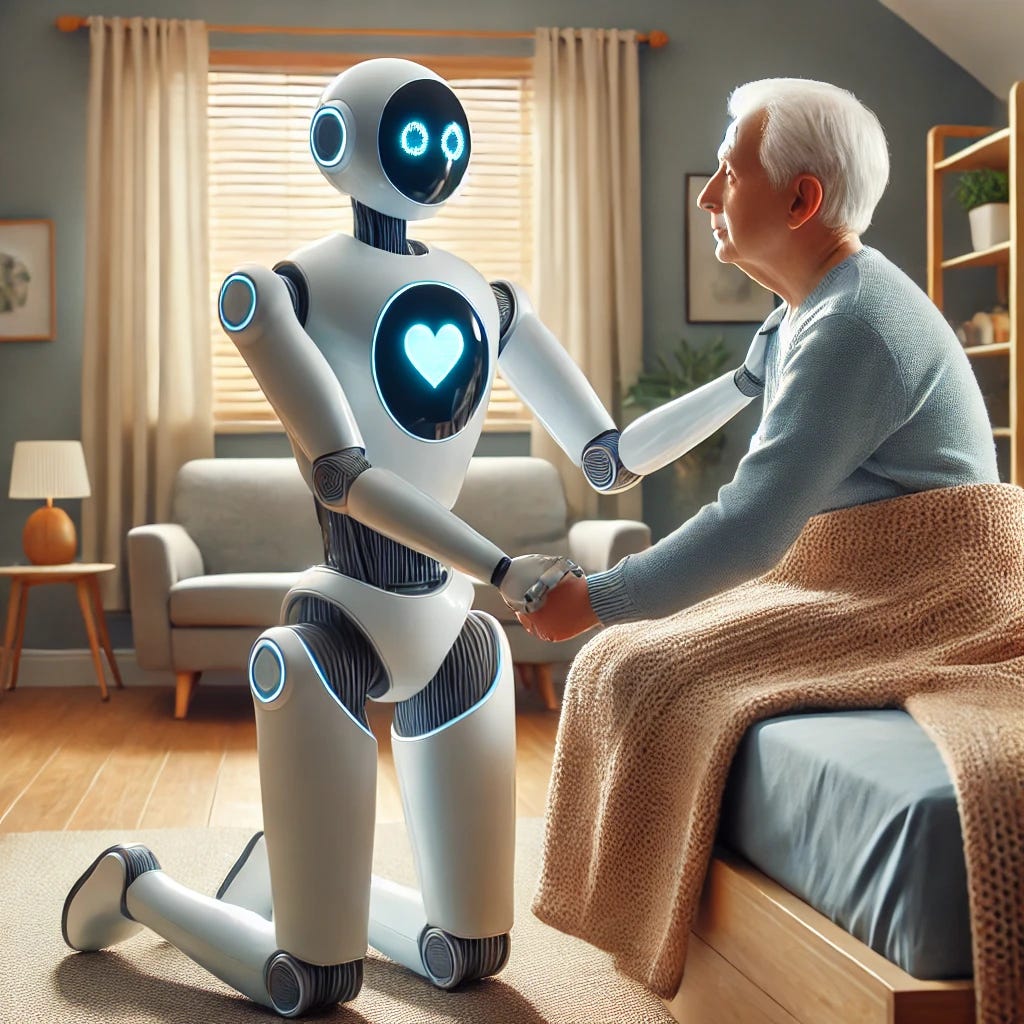The Future of Robotics in Disability Care: Independence Within Reach
For decades, the dream of robotic assistants helping people with disabilities achieve full independence has remained just that—a dream. However, rapid advancements in robotics, artificial intelligence, and sensor technology are bringing us closer to a future where individuals with mobility challenges can rely on robotic caregivers for everyday tasks like getting out of bed, walking, showering, and taking medication. While Japan has led the charge in developing assistive robots, adoption in the United States has been slow. Meanwhile, China is rapidly scaling its robotics industry, posing a serious challenge to U.S. innovation in the field of personal care robotics.
The Origins: Japan's Early Investment in Robotic Care
Japan has been a pioneer in robotic caregiving, largely driven by its aging population and shrinking workforce. Companies like SoftBank Robotics, Cyberdyne, and Panasonic have developed robotic exoskeletons, personal assistants, and mobility aids designed to help people with disabilities or seniors live more independently. For instance, Cyberdyne’s HAL (Hybrid Assistive Limb) exoskeleton enables individuals with spinal cord injuries to regain mobility by amplifying their physical movements. Similarly, Toyota’s Human Support Robot (HSR) assists individuals with limited mobility by performing household tasks. These innovations have laid the groundwork for global developments in personal care robotics.
The U.S. Lag: Why Adoption is Slow
Despite significant technological progress, the U.S. has been slow to integrate personal care robotics into mainstream healthcare. Several factors contribute to this delay:
Cost: Advanced robotic systems remain prohibitively expensive. Unlike Japan, where the government heavily funds eldercare robotics, the U.S. healthcare system relies on private insurance and out-of-pocket expenses, making widespread adoption financially unfeasible.
Privacy Concerns: Many Americans are wary of robotic assistants monitoring their daily routines, raising questions about data security and personal privacy.
Regulatory Hurdles: The U.S. Food and Drug Administration (FDA) and other regulatory bodies impose strict guidelines on medical and assistive devices, slowing innovation and deployment.
Cultural Barriers: The American preference for human caregivers, as well as skepticism toward automation in healthcare, has also hampered adoption.
Breakthroughs Needed for U.S. Adoption
For personal care robots to become commonplace in the U.S., several breakthroughs must occur:
Affordability: The cost of robotic assistants must decrease significantly, making them a viable alternative to traditional caregivers. Companies need to mass-produce cost-effective models and introduce flexible financing or leasing options.
Improved AI and Personalization: AI-driven robots must become more intuitive, adapting to an individual’s unique needs and routines. Advances in natural language processing and real-time learning will be crucial.
Regulatory Flexibility: The FDA and healthcare policymakers must streamline the approval process for assistive robotics, ensuring faster adoption without compromising safety.
Public Trust and Privacy Protections: Robotics companies must implement robust data security measures and educate the public on the benefits of robotic caregiving.
China’s Rise in Robotics: Will They Win the Personal Care Race?
While the U.S. lags, China is aggressively advancing its robotics industry. Companies like UBTech, Fourier Intelligence, and Pudu Robotics are developing AI-powered robots for healthcare, rehabilitation, and personal assistance. With strong government backing and a booming AI sector, China is positioned to dominate the global market for assistive robotics. Additionally, China’s lower manufacturing costs allow for mass production at competitive prices, potentially making personal care robots more affordable than ever.
Innovative Companies Driving the Future
Several U.S. and Chinese companies are leading the way in personal care robotics:
United States:
Tesla Robotics (Emerging) – Elon Musk has hinted at humanoid robots that could assist with household tasks.
Agility Robotics – Developing bipedal robots for mobility assistance.
ReWalk Robotics – Specializes in robotic exoskeletons for individuals with spinal cord injuries.
China:
Fourier Intelligence – Produces exoskeletons for rehabilitation and personal mobility.
UBTech – Creates AI-powered humanoid robots for caregiving and companionship.
Pudu Robotics – Designs service robots for healthcare facilities and home care.
The Cost Factor: Why Robotics Must Be the Answer
Currently, the cost of in-home personal care in the U.S. ranges from $5,000 to $10,000 per month. This is unsustainable for many families, and with an aging population, the demand for caregivers will only increase. Robotic assistants, if developed and deployed correctly, could provide an affordable alternative, ensuring individuals with disabilities can maintain independence without financial burden.
The Future is Now—If We Embrace It
Robotic assistants for personal care are not a distant fantasy—they are technologically feasible today. With the right combination of affordability, trust, and regulatory support, the U.S. can accelerate adoption and ensure that individuals with disabilities have access to life-changing technology. If the U.S. fails to act, China may dominate the market, leading the charge in personal care robotics for years to come. The future of independent living is within reach—but only if we are willing to embrace it.
References
https://pmc.ncbi.nlm.nih.gov/articles/PMC11387915/
https://urbanrobotics.net/revolutionizing-healthcare-role-medical-anthropology/
https://ascnews.com/2025/01/the-rise-of-surgical-robotics-in-ascs-breaking-barriers-to-adoption/
https://pmc.ncbi.nlm.nih.gov/articles/PMC6053611/
https://digitalcommons.odu.edu/cgi/viewcontent.cgi?article=1200&context=emse_fac_pubs
[https://journalofethics.ama-assn.org/article/how-does-robotic-assisted-surgery-change-or-safety-culture/2023-08
https://www.servicerobots.com/blog/healthcare-robots-challenges-of-adoption-deployment/
https://www.needle.tube/resources-46/Challenges-and-Solutions-in-Implementing-Robotics-in-US-Hospitals
Find us & follow us:
😍 💕 🌍 💜 😊 🚀Most important thing is to subscribe to keep updated with our latest podcasts, newsletters...etc.
Planetary Health First Mars Next is a reader-supported publication. To receive new posts and support my work, consider becoming a free or paid subscriber.
We might just lift off to Mars if the orbit is right! 😍 💕 🌍 💜 😊 🚀
In love & kindness,
Michael Mann, (😍 💕)
Disclaimer: the views of the participants are their own only and do not reflect the views of other participants, participants' organizations, etc or Planetary Health First Mars Next or the Host…….
This podcast is for informational purposes only and should not be considered professional or medical advice.
In addition if there are any mistakes or facts that need to be corrected please feel free to reach out to us so we can correct any statement.
Understand we are a self published entity and do the best we can.
If you have an idea or have an inspiring topic or know anyone that would be a great guest for our show please reach out to info@planetaryhealthfirstmarsnext.org


